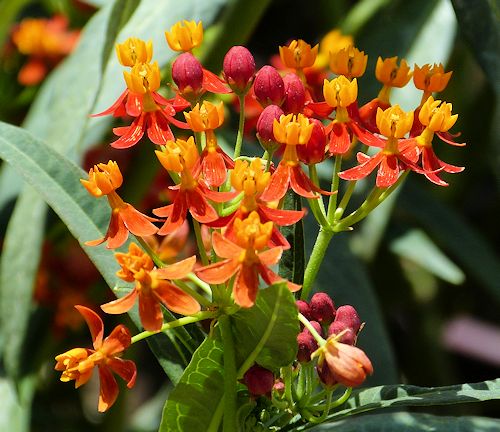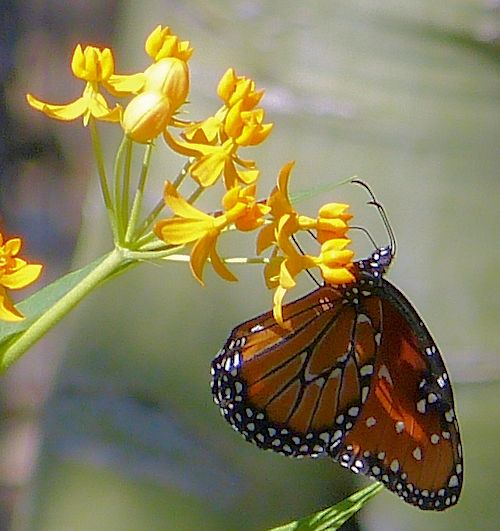Growing Asclepias tuberosa:
Butterfly Milkweed
Description
Form: Herb.
Lifespan: Perennial.
Growth rate: Slow.
Mature Size: 1-3' (30-100cm) high and wide.
Flowers: Small, bright orange or yellow, in flat-topped clusters.
Bloom: Spring, summer and fall.
Fruit: A tapered seed pod that splits open vertically (follicle) to release plumed seeds.
Leaves: Green, pointed, smooth-edged, narrow, 1.5-2" (3.8-5cm) long.
Stems: This plant has a single stem when young. Older plants grow multiple stems from a single tuber. This plant has a watery, translucent sap instead of the milky white sap of other milkweeds, and does not deter all browsing desert mammals.
Roots: This plant has a deep, tuberous taproot. It does not transplant once established.
Wildlife: The flowers attract butterflies. This plant is a caterpillar food plant for Gray Hairstreak, Monarch, and Queen butterflies. The leaves and stems are browsed by mammals.
Toxic / Danger: The sap of the entire plant and roots are mildly poisonous to humans.
Origin: North America. Often found on bare, dry, sunny slopes.
Form: Herb.
Lifespan: Perennial.
Growth rate: Slow.
Mature Size: 1-3' (30-100cm) high and wide.
Flowers: Small, bright orange or yellow, in flat-topped clusters.
Bloom: Spring, summer and fall.
Fruit: A tapered seed pod that splits open vertically (follicle) to release plumed seeds.
Leaves: Green, pointed, smooth-edged, narrow, 1.5-2" (3.8-5cm) long.
Stems: This plant has a single stem when young. Older plants grow multiple stems from a single tuber. This plant has a watery, translucent sap instead of the milky white sap of other milkweeds, and does not deter all browsing desert mammals.
Roots: This plant has a deep, tuberous taproot. It does not transplant once established.
Wildlife: The flowers attract butterflies. This plant is a caterpillar food plant for Gray Hairstreak, Monarch, and Queen butterflies. The leaves and stems are browsed by mammals.
Toxic / Danger: The sap of the entire plant and roots are mildly poisonous to humans.
Origin: North America. Often found on bare, dry, sunny slopes.
Cultivation and Uses
USDA hardiness zones: 4-10.
Heat tolerant: Yes.
Drought tolerant: Yes.
Soil: Well draining, dry, sandy to gravelly, low in nutrients, pH 5.6-7.5 (acidic to neutral).
Water once established: Once or twice a month.
Sun: Full sun to part shade.
Prune: Deadheading spent blooms triggers another bloom cycle about a month later.
Litter: Low.
Pests: Butterfly Milkweed is prone to aphids. Small mammals, such as the White-throated Woodrat, are known to repeatedly eat its leaves and small stems and eventually kill the plant.
Propagation: This plant is easily grown from seed, but it may take 2-3 years to flower when grown from seed.
Mulch: After leaf drop, mulch young plants in regions prone to freezes.
Uses: Ornamental, butterfly garden.
USDA hardiness zones: 4-10.
Heat tolerant: Yes.
Drought tolerant: Yes.
Soil: Well draining, dry, sandy to gravelly, low in nutrients, pH 5.6-7.5 (acidic to neutral).
Water once established: Once or twice a month.
Sun: Full sun to part shade.
Prune: Deadheading spent blooms triggers another bloom cycle about a month later.
Litter: Low.
Pests: Butterfly Milkweed is prone to aphids. Small mammals, such as the White-throated Woodrat, are known to repeatedly eat its leaves and small stems and eventually kill the plant.
Propagation: This plant is easily grown from seed, but it may take 2-3 years to flower when grown from seed.
Mulch: After leaf drop, mulch young plants in regions prone to freezes.
Uses: Ornamental, butterfly garden.
Comments
This plant is a member of the Dogbane family (Apocynaceae). Its sap is not as bad tasting as other milkweeds and its leaves are often browsed. It can be difficult to establish this plant without sufficient critter protection. A Queen Butterfly is shown.
Do you have additional information or a different experience for these plants that you would like to share? Email info@GardenOracle.com. All contributions are welcome and appreciated.
This plant is a member of the Dogbane family (Apocynaceae). Its sap is not as bad tasting as other milkweeds and its leaves are often browsed. It can be difficult to establish this plant without sufficient critter protection. A Queen Butterfly is shown.
Do you have additional information or a different experience for these plants that you would like to share? Email info@GardenOracle.com. All contributions are welcome and appreciated.



Latest update: September, 2024
© 2008-2025 by GardenOracle.com

